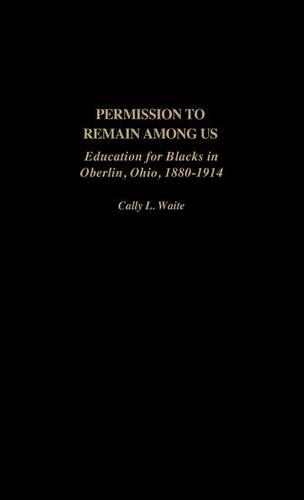
Permission to Remain Among Us: Education for Blacks in Oberlin, Ohio, 1880-1914
(Hardback)
Publishing Details
Permission to Remain Among Us: Education for Blacks in Oberlin, Ohio, 1880-1914
By (Author) Cally L. Waite
Bloomsbury Publishing PLC
Praeger Publishers Inc
30th December 2002
United States
Classifications
Tertiary Education
Non Fiction
Educational administration and organization
Ethnic studies / Ethnicity
Higher education, tertiary education
Social discrimination and social justice
History of the Americas
Racism and racial discrimination / Anti-racism
379.26097712309034
Physical Properties
Hardback
160
Width 140mm, Height 210mm
340g
Description
The community of Oberlin, Ohio, was founded as an evangelical community in 1833 and in 1834, Oberlin College became one of the first American colleges to admit black students. The story of Oberlin--both community and college--mirrors the story of race in America. The decision to admit black students to Oberlin College, and offer them the same curriculum as their white classmates, challenged the notion of black intellectual inferiority that prevailed during the antebellum period. Following the model of the college, the public schools of Oberlin were integrated in direct opposition to state laws that forbade the education of black children with public funds. However, after Reconstruction (1877), the nation tried to negotiate the future of a newly freed and barely educated people. In Oberlin, this change was evidenced by the gradual segregation of black students at the college. In the community, newly segregated neighborhoods, houses of worship and social interaction took hold in the former "interracial utopia." The country looked to Oberlin as a model for integrated education at the end of the 19th century only to find that it, too, had succumbed to segregation. This study examines why, and focuses on the intersection of three national issues: the growth of the black church, increased racism and discrimination, and the transformation of higher education.
Reviews
[W]aite has written an accessible, engaging, and provocative study that raises and answers important questions on topics that contiue to challenge our institutions of higher education.-The History of Education Quarterly
Cally Waite has put together a very interesting look at Oberlin College and its long history of educating African Americans. The book provides the reader with a good general background of education in Ohio and the difficult task of getting Ohioans to accept the notion of higher education for African Americans.-Ohio History
Permission to Remain Among Us has much to offer historians, sociologists, and higher education professionals. The case of Oberlin is a reminder that racially integrated education has always been subject to tolerances (that is, the degree to which one may deviate from a standard), even at institutions now perceived to be early "models" of integration. At Oberlin, those tolerances were both derived from and driven by localism, institutional factors, and historical events. At both Oberlin and Berea, the admission and rejection of Black students was dependent on religious, political, and economic parameters. Waite's deftly nuanced history of education for Blacks at Oberlin during the Progressive Era effectively synthesizes institutional history and case study, inviting comparison and reinterpreting primary sources within a lively narrative. It is, simply, a very good read.-Educational Studies
"Waite has written an accessible, engaging, and provocative study that raises and answers important questions on topics that contiue to challenge our institutions of higher education."-The History of Education Quarterly
"[W]aite has written an accessible, engaging, and provocative study that raises and answers important questions on topics that contiue to challenge our institutions of higher education."-The History of Education Quarterly
"Permission to Remain Among Us has much to offer historians, sociologists, and higher education professionals. The case of Oberlin is a reminder that racially integrated education has always been subject to tolerances (that is, the degree to which one may deviate from a standard), even at institutions now perceived to be early "models" of integration. At Oberlin, those tolerances were both derived from and driven by localism, institutional factors, and historical events. At both Oberlin and Berea, the admission and rejection of Black students was dependent on religious, political, and economic parameters. Waite's deftly nuanced history of education for Blacks at Oberlin during the Progressive Era effectively synthesizes institutional history and case study, inviting comparison and reinterpreting primary sources within a lively narrative. It is, simply, a very good read."-Educational Studies
"Cally Waite has put together a very interesting look at Oberlin College and its long history of educating African Americans. The book provides the reader with a good general background of education in Ohio and the difficult task of getting Ohioans to accept the notion of higher education for African Americans."-Ohio History
Author Bio
CALLY L. WAITE is Assistant Professor of History and Education at Teachers College, Columbia University.
